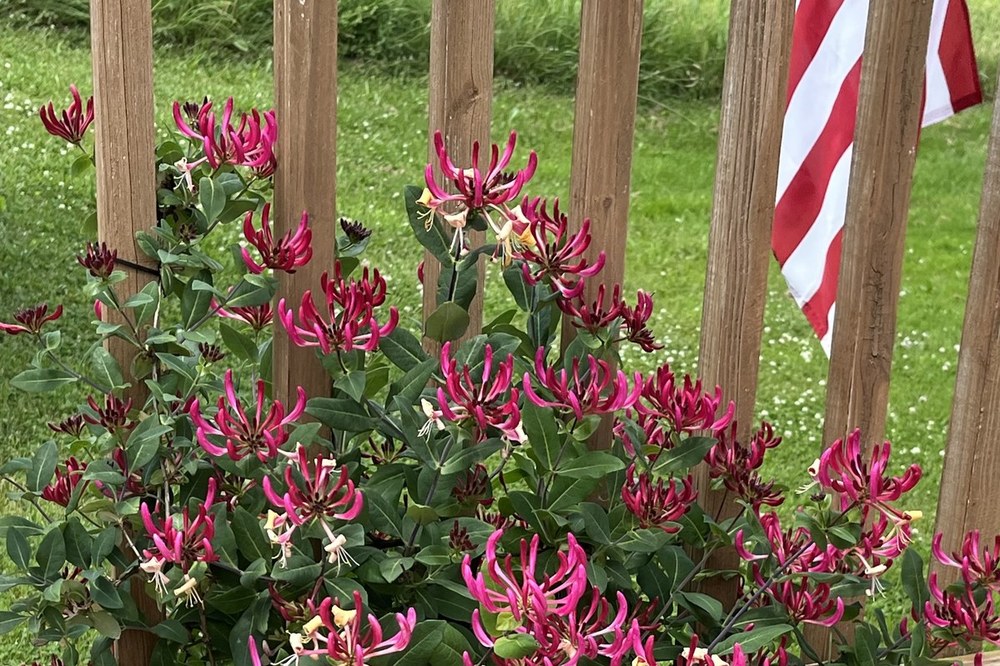Posted: January 3, 2025
"Honeysuckle." Even the name, the marriage of a sweet noun with a nurturing verb, evokes images of garden nirvana, a plant to satisfy multiple senses. And yet, under the same name, the invasive exotic species choke out our native shrubs and trees.

Lonicera sp. 'Peaches and Cream' is covered in masses of hot pink, peach, and yellow tri-colored trumpet flowers all season long., Photo by Holly Solano
All honeysuckles have fragrant spring flowers, ovate or elliptical leaves set in opposite pairs, and berries borne at the base of leaves in opposite pairs. Honeysuckle's growth habit ranges from a semi-evergreen woody vine to a deciduous shrub. So how do we distinguish among the invasive exotics, native plants, and garden-bred cultivars?
Invasive Honeysuckles
There are both vine and shrub habits of invasive exotic honeysuckles. Exotic shrub and vine honeysuckles can quickly take over areas through rapid growth and prolific seed production. Japanese honeysuckle (Lonicera japonica) is an invasive vine that is seen strangling trees, shrubs, and structures. It has tubular flowers that fade from pale yellow to white and can grow to 80-120 feet. Its berries are dark purple to black. Exotic shrub honeysuckles (Lonicera spp. maackii, morrowii, tatarica, bella, and standishii) also have tubular fragrant flowers ranging from white to yellow or white to pink, with shiny small round fruits that are red, orange, or pinkish in groups of four, paired along the stem. These bushes displace native vegetation, and the fruits of all four of these invasive honeysuckles do not contain the lipid (fat) content necessary to provide substantial nutrients to our local fauna. Removal of invasives is difficult due to seed dispersal and rapid growth. Small seedlings should be removed by hand; woody established plants need more aggressive controlling measures. Hard pruning to prevent fruit production will help curb the spread.
Due to the myriad of small mammals and birds that love to disperse their abundant berries, native and invasive honeysuckles can be found growing side-by-side, entangled with each other. So how does a responsible, well-intentioned land steward know what to remove? One way to discern what to chop out and what to leave is by checking the stems and leaves. The woody stems of all invasive honeysuckle species have hollow brown centers or piths. In native honeysuckles, the pith is solid. Also, all invasive bush honeysuckles have smooth leaf edges. Our native bush honeysuckle (Diervilla lonicera) has toothed leaf edges. It is also possible to confuse the native snowberry shrub with invasive shrub honeysuckles due to its similarly hollow pith. However, snowberry flowers are small, pink, and bell-shaped, and their fruit is white.
Native Honeysuckles
There are three known native honeysuckles in Pennsylvania: bush, American Fly, and Mountain Fly. Native honeysuckle has made the keystone plant list for our eastern temperate climate. Designation as a "keystone" plant means the species is now recognized and valued as a multiple-pollinator host. Native honeysuckles are host to 35 pollinators. All three natives have solid piths, allowing them to be distinguished from the hollow piths of exotic honeysuckle shrubs.
Native bush honeysuckle (Diervilla lonicera) has a mounding shrub habit and lance-elliptic opposite leaves. Its toothed leaf margin differentiates it from the smooth leaf edges of the invasive shrub honeysuckles. The flowers are funnel-shaped and hairy on the insides, initially pale yellow or even greenish yellow, aging from orange to red. Fruit is a green to brown narrow egg-shaped capsule (not a berry). Plants are self-sterile, requiring pollination from a different plant that is not a clone.
American Fly Honeysuckle (Lonicera canadensis) has pendant yellow flowers in pairs, followed by pendant red berries in pairs. Each pair of berries is fused together. American Fly Honeysuckle is classified as a Facultative Upland (FACU) plant, meaning that it usually occurs in non-wetlands but may occur in wetlands. This plant is fairly flexible in terms of site requirements. It can tolerate shade or part shade and dry to moist sites.
Mountain Fly honeysuckle (Lonicera villosa) has pairs of bell-shaped yellow flowers and non-abundant blue berries in non-fused pairs. It grows on the edges of fens and bogs but is not sighted often due to its endangered status in Pennsylvania. Mountain Fly honeysuckle is grouped with other blue-berried honeysuckles as "honeyberries" by permaculturists and foragers. The other blue-berried honeysuckles (Lonicera caerulea spp.) are native to Siberia and Canada.
Native honeysuckle plants can typically be purchased bare root in early spring from specialty or online nurseries. If you are lucky enough to have a local retail nursery that specializes in native plants, they may likely have some potted plants as well.
Garden Specialty Cultivars
Garden-bred honeysuckle cultivars available at retail and specialty nurseries offer larger flowers and specific flower color combinations. These cultivars come in yellows, pinks, oranges, reds, and bicolors. A popular garden favorite is Trumpet honeysuckle (Lonicera sempervirens), with its profuse display of large orange trumpet flowers. Lonicera sp. 'Peaches and Cream' holds a special place in this gardener's heart. Covered in masses of hot pink, peach, and yellow tri-colored trumpet flowers all season long, this showy vine is not to be missed. Loved by butterflies, bees, and hummers alike, this woody vine's non-aggressive compact climbing habit allows breathing space in your pruning schedule and less weight on your garden structures. Garden varieties rarely pose weed potential and are likely to take over only the structure given to grow on.
Holly Solano is a Penn State Master Gardener from Adams County. Penn State Cooperative Extension of Adams County is located at 670 Old Harrisburg Road, Suite 204, Gettysburg, 717-334-6271.
Master Gardener Hotline is open Wednesdays from 10 am to 2 pm. Please send an email (with pictures, if possible) to adamsmg@psu.edu with your gardening questions or stop by Penn State Extension, 670 Old Harrisburg Rd, Gettysburg.

